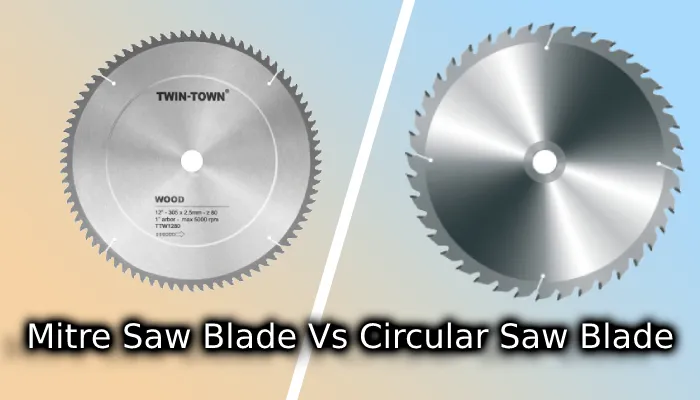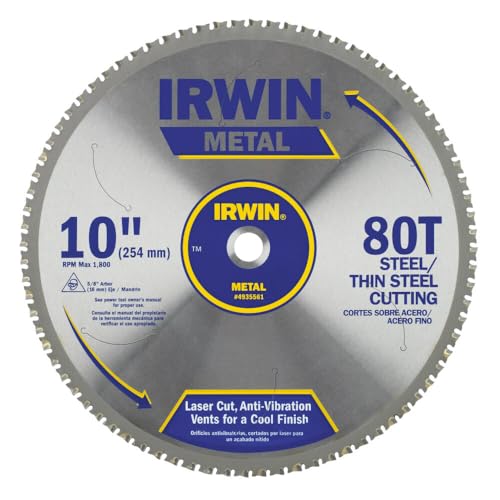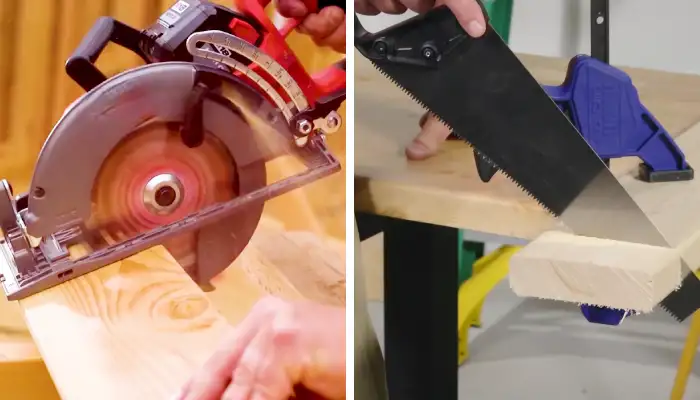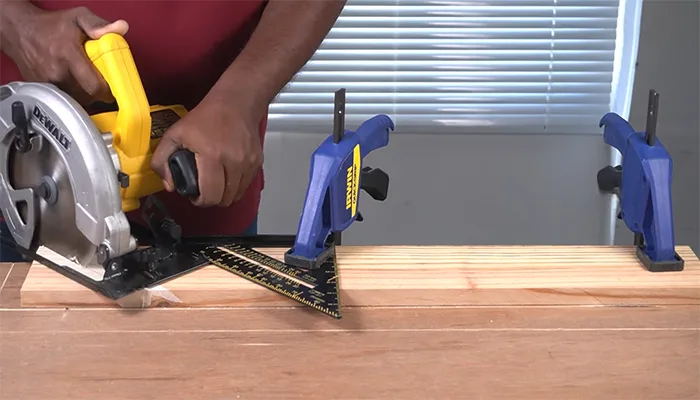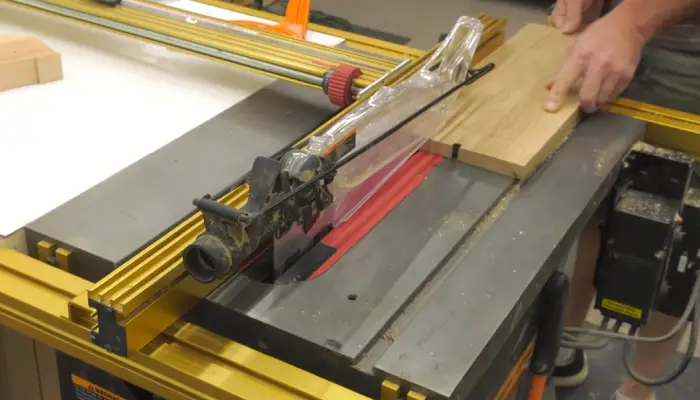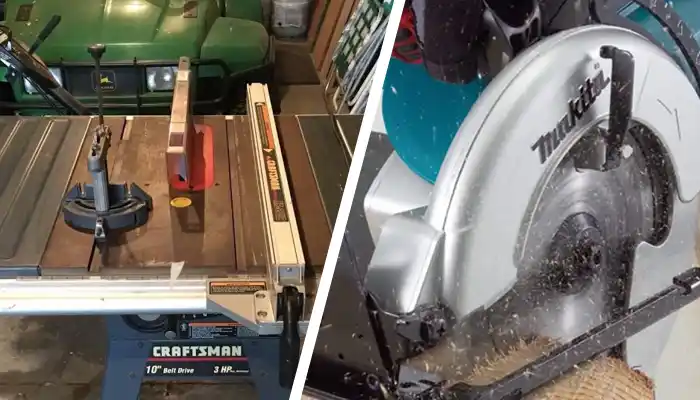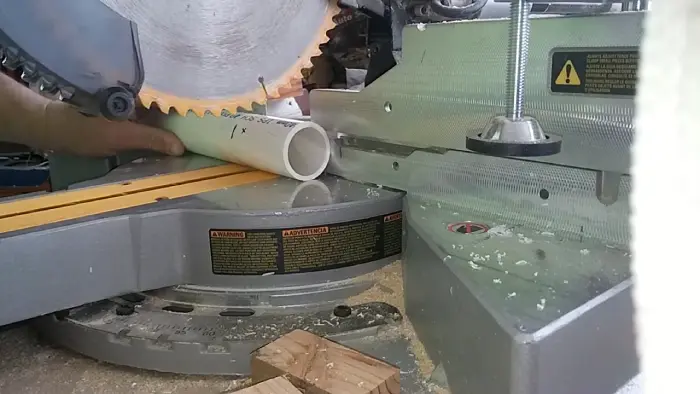Miter Saw Blade vs Circular Saw Blade: 5 Differences
Most woodworkers are confused about the differences between a miter and circular saw blades. That’s why I spent some time researching the topic and found a wealth of information that I would like to share with you.
Miter saw blades, which come in sizes of 8, 10, and 12 inches, have a higher tooth count for cleaner and more precise cuts. However, circular saw blades have fewer teeth for faster cutting speeds. Circular saw blades accept blades ranging from 4-1/2 to 7-1/4 inches in diameter, allowing for different cutting applications.
Throughout this article, I’ll discuss the world of saw blades, specifically the differences between circular saw blades and miter saw blades. By understanding the distinct features and applications of each, you can make informed choices and achieve optimal results in our woodworking projects.
- Tough Tungsten Carbide for Durability
- Thin Kerf for Fast, Smooth Cuts
- Computer-Balanced Plate for Accuracy
- Versatile Compatibility with Multiple Saws
- Expert Precision in Cross-Cutting and Ripping
- Advanced Tracking Point™ Tooth Design
- 5x Longer Cutting Life
- Efficient in Corded and Cordless Saws
- Enhanced Anti-Vibration Design
- Perma-Shield Non-Stick Coating
Differences Between Miter Saw Blade and Circular Saw Blade
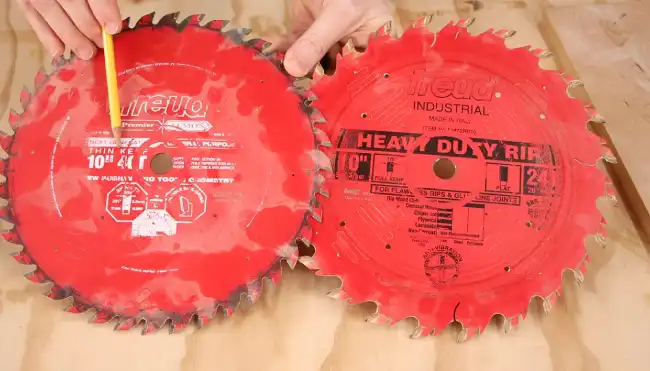
Several key differences stand out as I compare the miter and circular saw blades.
- Teeth count and labeling
- Blade size and material considerations
- Cutting geometry
- Cutting capability and precision
- Blade maintenance and cleaning
1. Teeth Count and Labeling
Miter saw blades are labeled based on the total number of teeth, typically ranging from 60 to 80. These blades are designed for angled cuts, providing smoother finishes on thicker materials. The higher tooth count allows more teeth to engage with the material, resulting in cleaner and more precise cuts.
Contrary to this, circular saw blades come with fewer teeth, ranging from 14 to 120. This makes them more versatile, excelling in straight cuts and grooves on various materials. The lower tooth count allows for faster cutting speeds but may sacrifice the smoothness and precision of the cut.
2. Blade Size and Material Considerations
Miter saw blades commonly come in sizes of 8, 10, and 12 inches. The blade’s size affects the cut’s depth and the saw’s overall capacity.
Regarding material considerations, miter saw blades can be made of steel or carbide-tipped material. Carbide-tipped blades offer increased durability and the ability to be resharpened.
In contrast, circular saws accept blades measuring from 4-1/2 to 7-1/4 inches in diameter. This versatility allows for different cutting applications. Circular saw blades also come in various types, such as diamond or multi-purpose blades, catering to different material cutting needs.
3. Cutting Geometry
The cutting geometry of a miter saw blade is specifically designed for angled cuts, allowing for greater accuracy and precision. I discovered that the increased teeth count and adjustable angles enable the blade to make clean and precise cuts at various angles.
On the other hand, circular saw blades operate in straight lines, providing less precision than miter saw blades. While they can still make accurate cuts, their design is optimized for straight cuts rather than angled ones.
Circular saw blades come in various tooth grinds, such as alternate top bevel (ATB) and flat top grind (FTG), which are suitable for different applications.
4. Cutting Capability and Precision
With their increased teeth count and adjustable angles, Miter saw blades provide accurate, precise angled, complicated cuts. They’re designed to deliver clean and smooth cuts, making them ideal for tasks requiring precision and accuracy, such as framing, trimming, and woodworking.
In contrast, circular saw blades are better suited for rough cutting, lacking the same level of precision as miter saw blades. They’re commonly used for straight lines and grooves on different materials, making them suitable for applications prioritizing speed and efficiency over precision.
5. Blade Maintenance and Cleaning

Since the miter saw blade is used for angled and precise cuts, it’s more prone to debris buildup. Therefore, regular cleaning is crucial to ensure optimal performance.
Before each use, inspecting the teeth and removing any accumulated debris is essential. This can be done using a stiff brush or compressed air to dislodge the particles.
Despite this, I can state that circular saw blades may become clogged with various types of debris due to their versatility. Recommended solutions such as simple green or oven cleaners can be used to clean them effectively. These solutions help break down the adhesive properties of the debris, making it easier to remove.
Comparison Table Between Miter Saw Blade & Circular Saw Blade
| Aspect | Miter Saw Blades | Circular Saw Blades |
| Teeth Count and Labeling | Labeled by total teeth (60 to 80), | Labeled by total teeth (14 to 120), |
| Direction and Tooth Geometry | Tooth pattern for angled cuts; greater accuracy with increased teeth count and adjustable angles. | Operate in straight lines; various tooth grinds (ATB and FTG) suitable for different applications. |
| Blade Size and Material | Commonly 10-inch or 12-inch; made of steel or carbide-tipped material (durable and resharpenable). | Varied sizes; come in different varieties like diamond or multi-purpose blades for versatility. |
| Cutting Capability and Precision | Excel in angled and complicated cuts; greater accuracy with increased teeth count. | Better suited for rough cutting; ideal for straight lines and grooves on various materials. |
| Blade Design and Performance | More teeth for smoother angled cuts; thinner due to specialized tooth shapes; requires less speed and power. | Fewer teeth, more powerful; suitable for tougher projects like cutting through concrete. |
Types of Miter Saw and Circular Saw Blades
Various options are available for both saws, each designed for specific cutting tasks. I will now discuss the different miter and circular saw blade types.
Miter Saw Blades
Different types of miter saws are available, each requiring a specific type of blade.
1. Crosscut Blade
A crosscut blade for a miter saw is essential for precise and efficient cutting. It’s specifically designed for crosscutting, requiring a high tooth count and smaller gullets.
The high tooth count allows for cleaner, smoother cuts, while the smaller gullets prevent the wood from getting stuck during the cutting process. Also, the crosscut blade typically has a negative hook angle, which aids in smoother wood entry, resulting in more accurate and controlled cuts.
2. Combination Blade
One popular option for a miter saw blade is a combination blade, which offers versatility for cutting various materials with precision and efficiency. This blade suits materials beyond pure lumber, such as plywood or particle board. It enables clean cuts on lumber while also handling diverse materials.
The combination blade is designed to enable the user to tackle different cutting tasks with one blade, making it a convenient choice for those who work with various materials.
3. Carbide-Tipped Blades
I suggest using a carbide-tipped blade on a miter saw to cut through dense hardwood efficiently. Carbide-tipped blades are made with a strong, durable material that allows for precise cutting, even in challenging materials.
The carbide tips on the blade stay sharp for longer periods, reducing the need for frequent blade changes. This blade type is ideal for precision work on a miter saw, providing easy, clean and accurate cuts through dense hardwood.
Circular Saw Blades
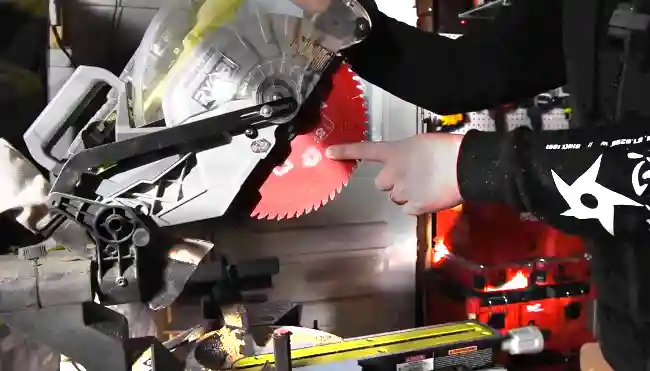
There are several types to consider when it comes to circular saw blades.
1. Standard Circular Saw Blades
You can efficiently cut through hardwood and wood composites using a sharpened blade with a standard circular saw. The tooth count is vital in determining the cutting speed and finishing quality.
The gullets between the teeth effectively eliminate wood chips, ensuring a clean and precise cut. Additionally, expansion slots prevent the blade from warping, maintaining its stability during operation.
These features make standard circular saw blades highly suitable for various woodworking applications.
2. Rip-Cut & Cross-Cut Blades
Continuing from the discussion on standard circular saw blades, the type of cuts they’re designed for is an important consideration when choosing between a miter saw blade and a circular saw blade.
Rip-cut blades are specifically designed for cutting along the wood grain, while cross-cut blades are intended for cutting across the grain. Combination blades are also available for rip and crosscutting purposes, providing versatility for different cutting tasks.
3. Continuous-Rim Blades
I suggest using a continuous-rim blade for a circular saw, as it provides a smooth and precise cut. These diamond-edged blades are designed for materials like tile and slate, offering a clean finish.
They come in variations for dry-cutting, wet-cutting, and versatile applications. These blades have a continuous rim of diamond grit, which ensures consistent cutting performance and reduces chipping.
4. Turbo-Rim Blades
A turbo-rim blade is a versatile option for circular saws. It offers enhanced cutting power and durability. Its serrated rim is similar to that of continuous-rim blades, but it also offers the benefit of increased cutting speed.
This blade is designed for cutting materials such as brick and concrete, making it suitable for wet and dry applications. While it may not provide the cleanest finish, its superior cutting performance makes it a popular choice for heavy-duty projects.
5. Segmented Blades
Segmented blades can enhance the cutting performance of miter and circular saws in several ways. First, these blades are designed to cut quickly and handle tough materials such as concrete and stone. Second, they are available for wet and dry applications, providing versatility depending on the cutting needs.
One of the key features of segmented blades is their segmented rim with gaps between each segment. This design allows for efficient cooling and debris removal during cutting, preventing overheating and ensuring a smoother cutting process.
However, while segmented blades effectively cut through tough materials, the finish may be rougher compared to other blade types. Nonetheless, their ability to handle challenging materials and efficient cooling and debris removal make segmented blades valuable for circular saws.
6. Abrasive Blades
Abrasive blades are used to cut hard materials such as concrete and stone. Unlike segmented blades, abrasive blades don’t have teeth. Instead, they cut through the material using abrasive materials like aluminum oxide or carbide silicon. These blades are ideal for tough cutting applications that require precision and durability.
Can I use a circular saw blade on a miter saw?
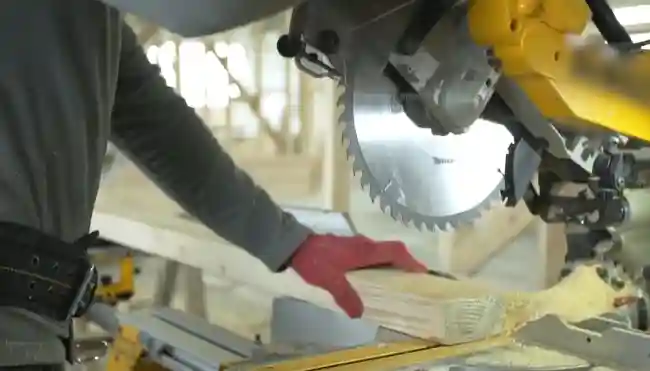
Using a circular saw blade on a miter saw is possible. Circular saw blades are designed to be versatile and can be used with various cutting devices, including miter saws, radial arm saws and table saws. However, there are a few considerations to keep in mind.
- Ensure that the circular saw blade is compatible with the arbor size of your miter saw. The arbor size refers to the diameter of the hole in the blade’s center that fits onto the saw’s spindle.
- Check the RPM (revolutions per minute) rating of the blade and the miter saw. Matching the RPM ratings is essential to ensure safe and effective cutting.
- Consider the tooth count and the blade type for the specific cutting application.
Are Miter saw blades universal?
Miter saw blades aren’t usually universal between brands, so ensure the tooth count, maximum speed, bore size, and kerf thickness are compatible before buying one. Using an incompatible blade can lead to unsafe operation and potential damage to the saw.
- The tooth count refers to the number of teeth on the blade, which affects cutting efficiency and quality.
- The maximum speed rating is important because using a blade that exceeds the recommended speed can result in overheating and blade failure. The bore size must match the saw’s arbor size to ensure proper fit and secure attachment.
- Lastly, the kerf thickness determines the width of the cut and should be compatible with the saw’s cutting capacity.
Considering these factors will help ensure optimal performance and safety when using a miter saw.
Choose the Appropriate Blade for Optimal Performance and Safety
To ensure optimal performance and safety, you should understand the differences between a miter and circular saw blades. While both blades have specific purposes, I don’t recommend using a circular saw blade on a miter saw due to potential risks.
Statistics show that using the correct blade for the intended tool can significantly improve cutting efficiency and minimize accidents.
Whether you’re aiming for detailed woodworking or versatile cutting options, the right blade choice is the key to achieving optimal results in your craft. Therefore, choose the right blade for the job at hand.
- Induction-Brazed Carbide Tips
- Heat-Treated Plate for Warp Prevention
- Precision Ground Teeth for Accuracy
- Corrosion-Resistant Coating to Prevent Rust
- Combo Pack: 24T Framing, 60T Fine Finish Blades
- Precision Cutting with Laser-Cut Blades
- Durable Metal-Cutting Carbide Teeth
- Cooler Touch, Smoother Finish
- Extended Blade Lifespan
- Cost-Efficient Metal Cutting Solution
Last update on 2025-11-23 / Affiliate links / Images from Amazon Product Advertising API

